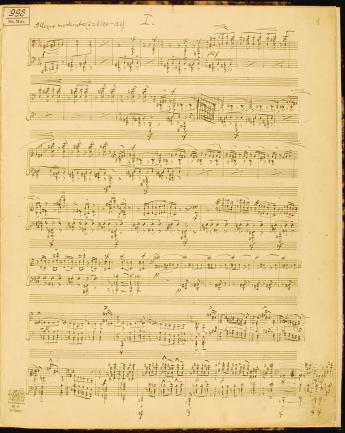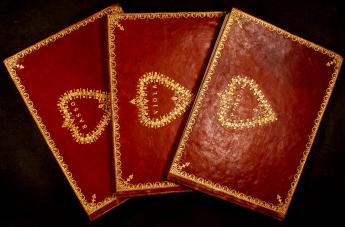Magyar Antikváriusok Egyesülete Bosze Adam Zenei Antikvarium / Adam Bosze Music Antiquarian
Collecting Music in Hungary

By Ádám B?sze
I procrastinated writing this text for a very long time, and I spent the last few weeks wondering why it was so hard to write about what I do. After some self-scrutiny it became clear that primarily, it was my laziness that prevented me from doing so. At the same time, I was also forced to realize that I would have to be painfully honest in this article, if I really intended to provide an authentic picture of collecting music in Hungary. It makes sense to start with institutional collections since private clients only rarely spend money on old sheet music, books on music and authographs.
Naturally, memorabilia of Hungarian music history are placed first. In this respect the Music Archive of the National Széchényi Library represents the guidelines. Count Ferenc Széchényi donated his Hungarica Collection of books, manuscripts, engravings and maps to the Hungarian nation in 1802, and by doing so he became the founder of the library. Only few people are aware of the fact that in accordance with the customs of the time the collection also contained music. The archive became independent in 1924 with the purpose of collecting all works of music related to Hungary.
The 17th century Bártfai Collection, the autograph of the Hungarian national anthem (by Ferenc Erkel), the autograph of the Rákóczi March arranged for orchestra by Héctor Berlioz or the autograph of Béla Bartók’s Sonata from 1926 are especially noteworthy. It is on purpose that the so-called Esterházy Collection is listed last since most music collections in Hungary are based on the legacy of one of the more significant composers.
The Esterházy Collection of the National Széchényi Library guards the most memorabilia of the life and work of Joseph Haydn, the Liszt Museum possesses relics of the virtuoso composer of Romanticism, Franz Liszt, while the Bartók Archive in the Institute for Musicology takes care of Béla Bartók’s legacy. But that takes us too far ahead already. The original Esterházy music collection was confiscated by the state in 1949 and was overtaken by the National Széchényi Library. The library’s final collection was the fusion of two libraries, the one of Esterházy and another, the Festetics Library, which had been levied before. This unified collection was later expanded by further acquisitions. Although Haydn can be called „Hungarian” only topographically, the above-mentioned collection turns the Music Archive of the Széchény Library into one of the top collections of the world.
The Liszt Memorial Museum is situated in Franz Liszt’s last residence in Budapest, on the first floor of the Old Academy of Music, where he lived from 1881 until 1886. The museum contains Liszt’s original instruments, furniture, collection of books and music as well as personal belongings. Research on Liszt in Hungary is centred in this institution. Luckily, the management of the museum continuously monitors the international antiquarian booktrade, and as a result, memorabilia connected to Liszt often conclude their journey here.
The Bartók Archives of the Hungarian Academy of Sciences – originally a multi-profile musicological research institute – was opened on September 25, 1961, in the Castle district of Buda (Országház utca 9., Budapest I, in the neighborhood of the present location), under the directorship of Bence Szabolcsi. The Bartók Archives was an independent department of this institute. Denijs Dille, a Belgian Bartók expert, sought out for this post by Zoltán Kodály, became its first Director. The “Bartók Hagyaték” (Bartók Estate), owned by Béla Bartók Junior (d. 1994) but deposited as a permanent loan to the Hungarian Academy of Sciences, formed the kernel of the collection. This was extensively enlarged with material from Bartók’s Hungarian publishers (Rozsnyai, Rózsavölgyi, etc.), and private collectors, including Mrs. Emma Kodály. Unfortunately, the Archive was practically cut from the American sources. As a result of the policy of the Budapest and New York Bartók archives, aggravated by cold-war politics, family and legal matters, for two and a half decades the autograph sources were available to the international community of scholars and the public only to a very limited extent. In 1984 the Bartók Archives, as part of the enlarged and renamed Institute for Musicology (incorporating Kodály’s one-time Folk Music Research Group, too), moved to its present address.
It would now be time to mention the private collections and shops which have valuable and rare pieces of music on offer. Unfortunately, only very few people can afford to build up a music collection in present day Hungary, and consequently, in Budapest there are hardly any experts on rare music scores. Now and then, a more valuable title turns up in the long-established Rózsavölgyi or Kodály music shops, but to those who are in quest for especially rare music scores or books, I cannot do otherwise than recommend my own antiquarian bookshop.
Thank you very much to Ádám B?sze for giving us permission to publish his article on the ILAB website.
>>> Musikantiquariat Adam Bosze
>>> Music Archive of the National Széchényi Library
>>> Liszt Memorial Museum
>>> Bartók Archives


